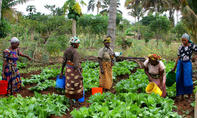The organisational structure of a farm is an important aspect of managing a farm. It will not only have an effect on the management of a farm’s finances but also have an effect on the speed and ease of decision-making and even the taxes that a farmer has to pay.

When deciding on the best organisational structure to manage a farm, you need to keep in mind the availability of funds, type of farm, capital needs of the farm, responsibility (liability), profit-sharing amongst owners, decision-making powers and cost and tax implications.
In order to choose the best organisational structure for a farm, ask for advice from lawyers, financial advisors, bankers and tax experts. Some organisational structures for farms are discussed below.
Sole Proprietorship
The farm is owned by one person (usually the farmer) who runs the farm. The owner has a personal VAT number and is responsible for all the decisions made and all losses or claims against the farm, but gets all the benefits when the farm makes a profit.Partnership in a Farm
A partnership consists of two to 20 persons and has access to more capital than a sole proprietorship. Losses, claims and profits are shared between the partners and all the partners are responsible for the management of a partnership. A partnership stops to exist when a partner steps out or dies.A Farm as a Company
As the farm grows, to organise and run it as a company can be beneficial in terms of management and taxation. Members of a company (shareholders) share in the profits, which are divided in the form of dividends.
A company is a more formal organisational structure and suitable for a large farming business. It usually has access to more capital, is managed by a board of directors and does not stop to exist in case of the death of one of its shareholders.
Cooperative
A cooperative is usually started by a group of individuals, at least seven people, that has the same need or purpose - for example, to start a processing plant to make juice. These needs can be to get inputs such as seed or feed cheaper through having more bargaining power.
This may be better achieved by a group rather than an individual. The main purpose of a cooperative as an economic unit is to promote their members by rendering services, rather than to maximise profits. The decisions regarding management decisions are made by the directors of the cooperative.
A Farm as a Trust
A trust is usually formed for the purpose of taxation and inheritance (especially in the case of children under 18) and can consist of one to 20 members, which are called trustees. These trustees are responsible for the management of the trust. When a trustee dies, the continuity of the trust depends on the trust deed.A Close Corporation
A close corporation is an inexpensive business structure with the advantages of a company, but less formal. The members, which can range from one to 10 persons, are not responsible for claims or losses, except where they signed as sponsors.
Profits are divided according to a written agreement and all members participate in the management and decision-making of the close corporation. A close corporation does not cease to exist in the case of the death of a member.
Source Water Research Commission